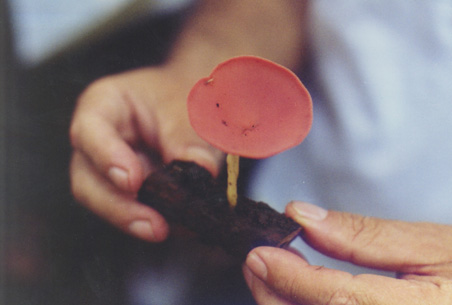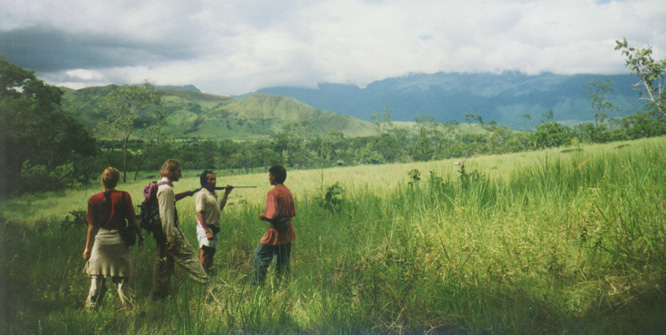CHEMICAL ECOLOGY ABSTRACTS
Plant-Ant Symbioses in the Understory Melastomataceae of Two Neotropical
Rain Forests
García, A.E.1, F. A. Michelangeli1, F.I.
Michelangeli2, and E. Rodriguez1
(1Cornell University,
2IVIC; Research conducted
at the Yutajé research station and IVIC, Venezuela 1996)
The symbiotic associations between ants and plants are common phenomena in
tropical rainforests. By far Melastomataceae is the plant family with the
largest amount of species with such associations. Two different study sites
were chosen for the present study. In both study sites, all Melastomataceae
species bearing ant domatia were identified and collected along with their
inhabiting ants. Exclusion experiments were also performed in order to assess
the importance of the ants to the biology of the plants. Azteca was
the only ant genus present at one of the sites, while at the other
Pheidole sp. and Crematogaster sp. were found in association
with the plants. The genera of Melastomataceae present were Tococa
Aubl. and Myrmidone Mart. The diversity of ant species per host and
per locality is discussed. Data of other ant-plant associations in the same
area (i.e. Fabaceae, Moraceae, and Boraginaceae) is also considered.
Hummingbird-Plant Interactions in the Venezuelan Amazon
Burke, J.C.1, D. Rosane2, F.I.
Michelangeli3, and E. Rodriguez1
(1Cornell University,
2Fundación Terramar,
3IVIC; Research conducted
at the Yutajé research station and IVIC, Venezuela 1997)
Hummingbirds and plants often posess a symbiotic relationship. Plants provide
life-sustaining nectar for the birds to consume, while hummingbirds provide
effective means of pollination for the plants. Coevolution has brought about
the morphological changes in both parties that have enabled them to maximize
the efficiency of their relationship. The extent of this relationship between
7 species of Venezuelan Amazonian hummingbirds, and the flowering plants
Hamelia patens Jacq. (Rubiaceae), Costus spiralis (Jacquin)
Roscoe (Costaceae), and Costus guanaiensis Rusby (Costaceae) was
investigated. Observations of feeding behavior at floral patches showed that
57% of the H. patens flowers visited by A. versicolor were
probed, and 94% of the C. spiralis flowers visited by P.
squalidus were probed. SEM analysis of pollen grain samples taken from
the beaks of P. squalidus and C. notatus showed that the most
abundant pollen on their beaks belonged to the genus Costus. Costus
spiralis appeared to have the most rewarding relationship with C.
notatus. A. versicolor benefits from its relationship with H.
patens, although evidence suggests that it may not be the most efficient
pollinator of this plant species.

Comparison of pollen grains obtained from the beaks of Chorestes
notatus (upper left) and Phaethomis squalidus (bottom)
with those of Costus spiralis (upper right) indicate that these
bird species feed upon the flowers of this C. spiralis.
Photo by Jennifer Svitko
Mysterious Mushrooms of the Neotropics: The Ecology, Chemistry,
Biological Activity, and Ethnomycology of Four Color Variants of Cookeina
sulcipes (Berk.) Kuntze (Pezizales, Sarcosyphaceae)
Samuels, K.¹, T. Iturriaga2, F.I.
Michelangeli3, and E. Rodriguez4
(¹Emory University,
2Universidad Simon Bolivar, 3IVIC,
4Cornell University; Research conducted at the Yutajé
research station and IVIC, Venezuela 1997)
Neotropical rain forests contain one of the world's most diverse assemblages
of fungal species. In spite of this variety, the fungi of the tropics and
sub-tropics are poorly studied and understood in terms of their chemistry
and ecology. Past chemical and antibacterial research on these fungi has
focused mainly upon a few species of edible jelly fungi and soil bacteria
which have yielded promising anti-cancer and antibacterial compoounds,
respectively. This project presents the results of an investigation into
the ecology, chemistry, and biological activity (i.e. anti-bacterial, anti-viral,
anti-malarial, and cytotoxic properties) of Cookeina sulcipes, as
well as a cursory investigation of potential medicinal and/or nutritional
use of this species among Piaroa communities in the area surrounding the
Yutajé research station. The ecological component of this study
investigates the distribution of this abundant (both throughout the tropics
and in the Yutajé region) fungal species, with a particular focus
on the habitat features that may cause the expression of four different color
varieties of C. sulcipes. Preliminary ecological data suggests that
there is a correlation between the four diferent color varieties of C.
sulcipes and their apothecia size. Data also suggests a correlation between
habitat type and the frequency and abundance of the color varieties of this
fungal species, with the greatest diversity being found in the white-water
terra-firme rain forest. Assay results demonstrate a mild inhibitory effect
against Salmonella sp. This species of fungi was not found to be used
nutritionally nor medicinally by the Piaroa, although reports exist that
this species is eaten by indigenous people in Mexico.

A Cookeina sulcipes apothecium.
Photo by Gustavo Azenha '98
Chemical Ecology of Food Items of Five Frugivorous Amazonian
Birds
Schwartz, M.J.1, D. Rosane2, F.I.
Michelangeli3, and E. Rodriguez1
(1Cornell University,
2Fundación Terramar,
3IVIC; Research conducted
at the Yutajé research station and IVIC, Venezuela 1997)
Birds have long puzzled observers by eating fruits known to contain toxic
compounds. Birds may be using a fruit's based on the palatability of
anti-bacterial, anti-fungal, or anti-parasitic properties compounds. It is
also possible fruits have evolved mild toxicity in order to improve dispersion.
Five frugivorous neotropical birds, Ara chloroptera, Pionites
melanocephala, Amazonas ochrocephala, Tyrannus savana,
and Etaenia cristata, were observed over a six-week period with regards
to diet. Items the birds ate were recorded, collected, and identified. Of
primary interest was the chemical composition of food items. An extraction
of each food item was done with 70% ethanol to determine the presence and
type of secondary compounds the birds were ingesting. Fruits were collected
from the following genera: Caryocar Linn. (Caryocaraceae),
Byrsonima L.C. Rich. ex Kunth (Malpighiaceae), Alchornea Sw.
(Euphorbiaceae), Protium Burm f. (Burseraceae), Erythroxylum P.
Browne (Erythroxylaceae). Protease inhibitors were found in the pulp of
Alchornea sp. and Erythroxylum sp. Caryocar sp. was
found to have cytotoxic activity. Further work is being conducted on the
potential biomedical uses of these compounds.

Students Miguel Schwartz and Jackie Burke work with Piaroa collaborators
to learn about the local bird diversity and ecology in the vicinity of
Guanai.
Photo by Nicole Salgado '99
return to Emanations vol.1: no.1 contents page


